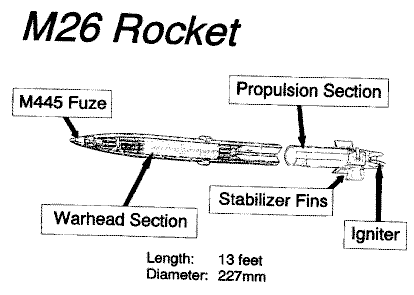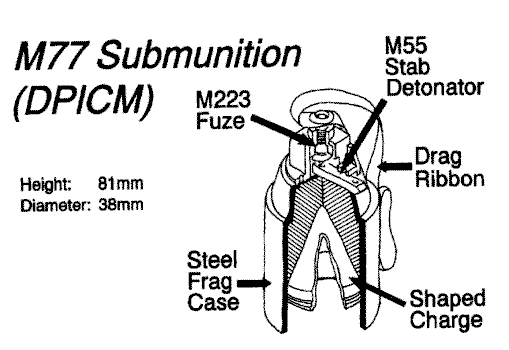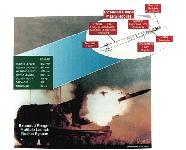 The Multiple Launch Rocket System (MLRS) provides the Army an all-weather, indirect, area fire weapon system to strike
counterfire, air defense, armored formations, and other high-payoff targets at all depths of the tactical battlefield. Primary
missions of MLRS include the suppression, neutralization and destruction of threat fire support and forward area air defense
targets.
The Multiple Launch Rocket System is a versatile weapon system that supplements
traditional cannon artillery fires by delivering large volumes of firepower in a short time against
critical, time-sensitive targets. These targets often include enemy artillery, air defense systems,
mechanized units, and personnel. MLRS units can use their system's "shoot and scoot" capability to
survive while providing fire support for attacking manuever elements. MLRS is not intended to
replace cannon artillery, but has been designed to complement it.
MLRS performed extremely well in Operation Desert Storm (ODS) in which significant numbers of
launchers were deployed. All operational requirement were met and, in most cases, exceeded levels for readiness, reliability and maintainability.
The MLRS rockets are tube-launched, spin-stabilized, free-flight projectiles. The rockets are assembled, checked, and
packaged in a dual-purpose launch-storage tube at the factory. This design provides for tactical loading and firing of
the rocket without troop assembly or detailed inspection. Major components of the rocket assembly include four
stabilizer fins, a propulsion section, and a warhead section. Propulsion for the rocket is provided by a solid propellant rocket motor. An umbilical cable, passing through the aft
end of the launch tube, links the FCS to an igniter in the rocket nozzle. The motor is ignited by an electrical command
from the FCS.
Each rocket is packaged with the four fins folded and secured by wire rope retaining straps. As the rocket moves
forward upon firing, lanyard devices trigger a delayed strap-cutting charge. After the rocket leaves the launch tube, the
charge cuts the straps. This allows the fins to unfold and lock. The M28 and M28A1 rockets' LPCs have an additional
fin release device to ensure deployment.
The MLRS rocket follows a ballistic, free-flight (unguided) trajectory to the target. The propulsion provided by the
solid propellant rocket motor is the same for each rocket, so rocket range is a function of LLM elevation. The four
stabilizer fins at the aft end of the rocket provide in-flight stability by maintaining a constant counterclockwise spin. The
initial spin is imparted to the rocket through spin rails mounted on the inner wall of the launch tube.
The Multiple Launch Rocket System (MLRS) provides the Army an all-weather, indirect, area fire weapon system to strike
counterfire, air defense, armored formations, and other high-payoff targets at all depths of the tactical battlefield. Primary
missions of MLRS include the suppression, neutralization and destruction of threat fire support and forward area air defense
targets.
The Multiple Launch Rocket System is a versatile weapon system that supplements
traditional cannon artillery fires by delivering large volumes of firepower in a short time against
critical, time-sensitive targets. These targets often include enemy artillery, air defense systems,
mechanized units, and personnel. MLRS units can use their system's "shoot and scoot" capability to
survive while providing fire support for attacking manuever elements. MLRS is not intended to
replace cannon artillery, but has been designed to complement it.
MLRS performed extremely well in Operation Desert Storm (ODS) in which significant numbers of
launchers were deployed. All operational requirement were met and, in most cases, exceeded levels for readiness, reliability and maintainability.
The MLRS rockets are tube-launched, spin-stabilized, free-flight projectiles. The rockets are assembled, checked, and
packaged in a dual-purpose launch-storage tube at the factory. This design provides for tactical loading and firing of
the rocket without troop assembly or detailed inspection. Major components of the rocket assembly include four
stabilizer fins, a propulsion section, and a warhead section. Propulsion for the rocket is provided by a solid propellant rocket motor. An umbilical cable, passing through the aft
end of the launch tube, links the FCS to an igniter in the rocket nozzle. The motor is ignited by an electrical command
from the FCS.
Each rocket is packaged with the four fins folded and secured by wire rope retaining straps. As the rocket moves
forward upon firing, lanyard devices trigger a delayed strap-cutting charge. After the rocket leaves the launch tube, the
charge cuts the straps. This allows the fins to unfold and lock. The M28 and M28A1 rockets' LPCs have an additional
fin release device to ensure deployment.
The MLRS rocket follows a ballistic, free-flight (unguided) trajectory to the target. The propulsion provided by the
solid propellant rocket motor is the same for each rocket, so rocket range is a function of LLM elevation. The four
stabilizer fins at the aft end of the rocket provide in-flight stability by maintaining a constant counterclockwise spin. The
initial spin is imparted to the rocket through spin rails mounted on the inner wall of the launch tube.


MLRS M26 basic tactical rocket
SYSTEM DESCRIPTION:The MLRS M26 basic tactical rocket was designed to complement cannon weapons in the tactical fires arena. The M26 tactical rocket provides devastating effects in attacking critical, time sensitive targets with large volumes of firepower in a very short time. The M26 is a free flight unguided tactical rocket that provides an all weather, indirect fire capability to attack artillery and air defense systems, personnel, and light materiel targets. The M26 tactical rocket warhead contains 644 M77 dual purpose improved conventional munition submunitions which can be deployed to cover a 0.23 square km area. SYSTEM CHARACTERISTICS:
Six M26 rockets are loaded in the launch pod/container (LP/C) at the factory. The six M26 rockets are shipped, stored, and fired from the LP/C. The M26 rocket is a wooden round with a shelf life of at least 15 years. The M26 provides the firepower superiority needed to silence enemy artillery and critical targets. This awesome capability was termed "steel rain" by the Iraqi commanders during Desert Storm.
Extended Range Rocket (ER) MLRS
 SYSTEM DESCRIPTION:
SYSTEM DESCRIPTION:The extended range MLRS is an ACAT II program within the MLRS Project Office. The ER MLRS is a free flight, area fire artillery rocket designed to engage targets beyond the range of the existing MLRS. The development program includes the addition of a low level wind measuring device on the M270 launcher to sustain accuracy and effectiveness at the longer ranges and the incorporation of a self destruct fuze on each submunition to increase safety for friendly maneuver forces. SYSTEM CHARACTERISTICS:
The ER MLRS is similar to the basic MLRS with the following changes. The ER MLRS includes a lengthened rocket motor and smaller warhead section with fewer submunitions, a new no-load detent system for securing and releasing the rocket, a modified center core burster, and a new warhead fuze. Additionally, each M85 Dual- Purpose Improved Conventional Munition (DPICM) submunition will be equipped with a self-destruct fuze. The system also includes the addition of a low level wind measuring device on the launcher.
The first in a series of low rate initial production (LRIP) contracts was awarded to Lockheed Martin Vought Systems (LMVS) on 31 July 1996 for 1326 ER-MLRS rockets. In February 1997, a second LRIP contract was awarded for an additional 1500 rockets. Delivery of these rockets was scheduled to start in 2QFY98. However, this start date was put into jeopardy due to the continuous development of the XM85 Dual Purpose Improved Conventional Munition (DPICM) grenade. The XM85 will reduce the hazardous dud rate (HDR) of the current M77 grenade to less than one percent, greatly improving friendly force maneuver.
Production and fielding of ER-MLRS rockets continues, with M26A2 ER-MLRS rockets fielded to storage sites in Korea for US Forces Korea. This is in accordance with the direction of the Deputy Chief of Staff for Operations and Plans (DCSOPS). In October 1997, DCSOPS, in response to an urgency of need request from Commander, US Forces Korea, waived the less than one percent hazardous dud rate (HDR) and directed that all ER-MLRS rockets (approximately, 4,300) be fielded to USFK by the end of 4QFY99. Currently, ER-MLRS rockets are loaded with the M77 Dual Purpose Improved Conventional Munition (DPICM) and are designated the M26A2. The M77 is the same DPICM as that in the M26 basic MLRS rocket. It has a hazardous dud rate of approximately 4%.
A production contract was awarded to the designer/builder of the M235 Self Destruct Fuze (SDF), an integral part of the M85 DPICM grenade. The M85 will reduce the hazardous dud rate (HDR) of the current M77 grenade to less than one percent, greatly improving friendly force maneuver. Upon completion of the equipment necessary to produce the SDF at the required high rates, approximately 1,200 M26A1 versions of the ER-MLRS will be manufactured and delivered to USFK in FY00. This will conclude the production run of ER-MLRS at approximately 4300 rockets for the US Army. Additionally, contracts were awarded to LMVS to produce M26A2 rockets for the Republic of Korea (ROK) and Bahrain. Delivery of rockets to ROK and Bahrain was in 2QFY99 and 3QFY99. Additional sales to foreign customers of both versions of the ER-MLRS were concluded prior to the end of 2QFY99.
M28A1 Reduced Range Practice Rocket (RRPR)
SYSTEM DESCRIPTION:The M28A1 Reduced Range Practice Rocket is a short range practice rocket used to train operational MLRS units. The design maximizes the number of firing ranges that will support MLRS live fire training. The rocket motor is the same one used by the M26 Tactical MLRS Rocket. SYSTEM CHARACTERISTICS:
The M28A1 is a short range training rocket used to train troops. The design is a standard M26 rocket motor with a ballasted blunt nosed warhead designed for training/test sites with short ranges. A special application software module is required for the launcher to recognize and launch the RRPR.


